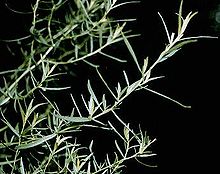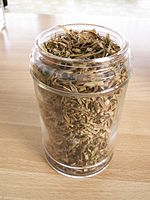- Tarragon
-
"Dragon's wort" redirects here. For other uses, see Dragonwort (disambiguation).This article is about the perennial herb. For the 1999 power metal album, see Taragon. For the Canadian theatre company, see Tarragon Theatre.
Tarragon 
Scientific classification Kingdom: Plantae (unranked): Angiosperms (unranked): Eudicots (unranked): Asterids Order: Asterales Family: Asteraceae Tribe: Anthemideae Genus: Artemisia Species: A. dracunculus Binomial name Artemisia dracunculus
L.Tarragon or dragon's-wort (Artemisia dracunculus) is a perennial herb in the family Asteraceae related to wormwood. Corresponding to its species name, a common term for the plant is "dragon herb". It is native to a wide area of the Northern Hemisphere from easternmost Europe across central and eastern Asia to India, western North America, and south to northern Mexico. The North American populations may, however, be naturalised from early human introduction.
Tarragon grows to 120–150 cm tall, with slender branched stems. The leaves are lanceolate, 2–8 cm long and 2–10 mm broad, glossy green, with an entire margin. The flowers are produced in small capitulae 2–4 mm diameter, each capitulum containing up to 40 yellow or greenish-yellow florets. (French tarragon, however, seldom produces flowers.[1])
Contents
Cultivation
French tarragon is the variety generally considered best for the kitchen, but is difficult to grow from seed. It is best to cultivate by root division. It is normally purchased as a plant, and some care must be taken to ensure that true French tarragon is purchased. A perennial, it normally goes dormant in winter.[1] It likes a hot, sunny spot, without excessive watering.[1]
Russian tarragon (A. dracunculoides L.) can be grown from seed but is much weaker in flavor when compared to the French variety.[1] However, Russian tarragon is a far more hardy and vigorous plant, spreading at the roots and growing over a meter tall. This tarragon actually prefers poor soils and happily tolerates drought and neglect. It is not as strongly aromatic and flavorsome as its French cousin, but it produces many more leaves from early spring onwards that are mild and good in salads and cooked food. The young stems in early spring can be cooked as an asparagus substitute. Grow indoors from seed and plant out in the summer. Spreading plant can be divided easily.
Health
Tarragon has an aromatic property reminiscent of anise, due to the presence of estragole, a known carcinogen and teratogen in mice. The European Union investigation revealed that the danger of estragole is minimal even at 100-1,000 times the typical consumption seen in humans.[2]
Usage
Culinary use
Tarragon is one of the four fines herbes of French cooking, and particularly suitable for chicken, lasagna, fish and egg dishes. Tarragon is one of the main components of Béarnaise sauce. Fresh, lightly bruised sprigs of tarragon may be steeped in vinegar to impart their flavor.
Tarragon is used to flavor a popular carbonated soft drink in the countries of Azerbaijan, Armenia, Georgia and, by extension, Russia, Ukraine and Kazakhstan. The drink, named Tarhun, pronounced [tarˈxuːn]; Тархун), is made out of sugary tarragon concentrate and colored bright green.
Cis-Pellitorin, an isobutylamide eliciting a pungent taste, has been isolated from Tarragon plant.[3]
In Slovenia, tarragon is used as a spice for sweet pastry called potica.
Companion plant
The scent and taste of tarragon is disliked by many garden pests, making it useful for intercropping as a companion plant, to protect its gardenmates. It is also reputed to be a nurse plant, enhancing growth and flavor of companion crops [1].
Etymology
The plant's common name and Latin name originate from the belief in the Doctrine of Signatures which suggested that a plant's appearance reflected its possible uses. The serpentine shape of Tarragon's root made herbalists believe it could cure snake bites. From this came the Greek name drakon (dragon), the Arabic tarkhum (little dragon), and the Latin name dracunculus (little dragon).[4]
References
- ^ a b c d McGee, Rose Marie Nichols; Stuckey, Maggie (2002). The Bountiful Container. Workman Publishing.
- ^ Surburg, Horst; Johannes Panten (2006). Common Fragrance and Flavor Materials: Preparation, Properties and Uses. Wiley-VCH. pp. 233. ISBN 9783527607891.
- ^ Gatfield IL, Ley JP, Foerstner J, Krammer G, Machinek A. Production of cis-pellitorin and use as a flavouring. World Patent WO2004000787 A2
- ^ Tarragon at Sally's Place
External links
- Germplasm Resources Information Network: Artemisia dracunculus
- NRCS: USDA Plants Profile: Artemisia dracunculus
- Flora of Pakistan: Artemisia dracunculus
Categories:- Artemisia
- Herbs
- Flora of Canada
- Flora of North Dakota
Wikimedia Foundation. 2010.

